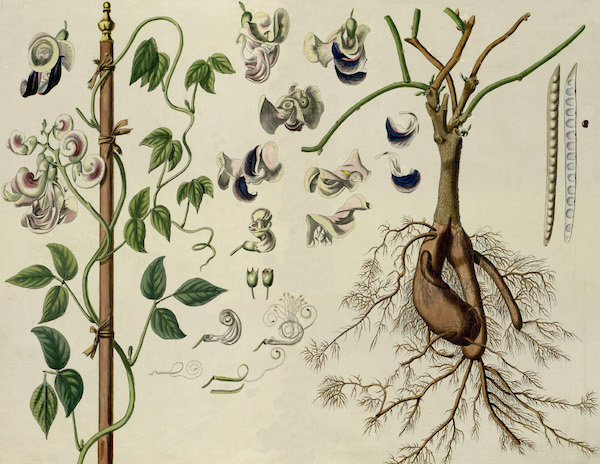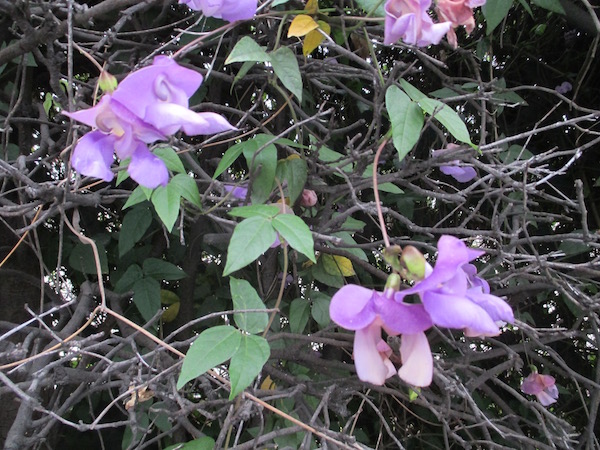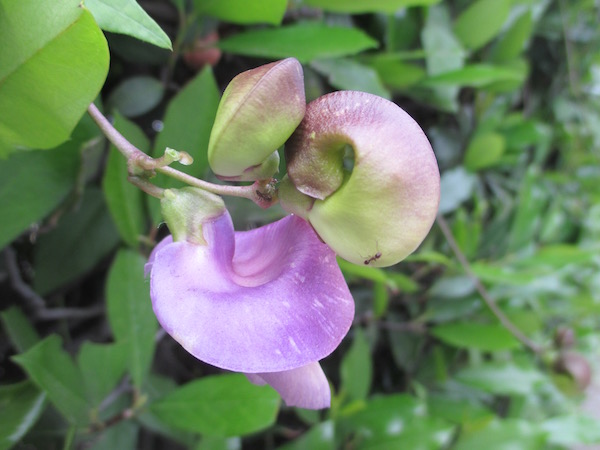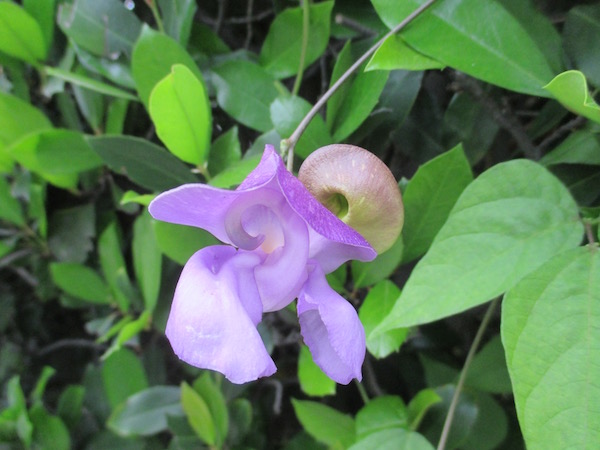Plant of the Month: June 2016
|
Snail-Flower Vines
|
| Snail-Flower Vine #1 |
| Cochliasanthus Caracalla (L.) Trew |
| = Phaseolus Caracalla L. |
| = Phaseolus cochleatus Vell. |
| = Phaseolus giganteus hort., p.p. |
| = Phaseolus pulcherrima Tod. |
= Vigna Caracalla (L.) Verdc.
|
| Snail-Flower Vine #2 |
| Sigmoidotropis speciosa (Kunth) A. Delgado 2011 |
| = Phaseolus speciosus Kunth |
| = Phaseolus giganteus hort., p.p. |
| = Vigna speciosa (Kunth) Verdc. |
= Vigna Caracalla hort., p.p., non (L.) Verdc.
|
LEGUMINOSÆ ; Pea Family
|
| Two related yet not identical South American bean-like species called Snail Flowers or Snail Vines, both sold as Vigna Caracalla are here featured. Both are robust perennials from tuberous roots, that, at least while young, in growth habit and foliage recall Scarlet Runner Beans (Phaseolus coccineus). The two Snail Flower vines have been, are, and will continue to be confused much. Both are grown exclusively as ornamentals, yet are edible withal, as are their relatives. It is annoying and complicated how their scientific names have changed so dramatically. |
| The first, when described scientifically in 1753, was called Phaseolus Caracalla. Phaseolus is the common bean genus, and the specific name Caracalla is from the Portuguese name for snail: caracòl. Next in 1970 it was transferred to the genus Vigna, a close relative of Phaseolus but a larger and older (in an evolution sense) genus. Since 2011, due to molecular genetic studies, plant taxonomists place Cochliasanthus Caracalla into its own genus. Nine English names for this species include: Snail Flower. Snail Vine. Pet-Snail Vine. Corkscrew Flower. Corkscrew Bean. Corkscrew Vine. Corkscrew Plant. Bertoni Bean. Snail Bean. It is native from S Mexico to N Argentina and Uruguay in wet forests. The flowers are bee- or ant-pollinated and produce much sweet nectar that people relish in Argentina. Some people eat the beans. |
| The second Snail Flower species, when described scientifically in 1824, was called Phaseolus speciosus. Next in 1970 it was transferred to the genus Vigna. Since 2011, due to molecular genetic studies, plant taxonomists place Sigmoidotropis speciosa into a genus of an indeterminate number of species (more than 9), all S American. Seven English names for Sigmoidotropis speciosa include: Snail Flower. Snail Vine. Purple Snail-Vine. Purple Giant Snail Vine. Corkscrew Vine. Shell Vine. Wandering Cow-Pea. It is native from Mexico to Colombia and Ecuador. It is stronger, and of the two species is the more likely to be called Phaseolus giganteus. |
| Cochliasanthus Caracalla was introduced in 1690 from Brazil to Portugal. Dates of introduction to North American gardens are difficult to ascertain due to the confusion, but Thomas Jefferson knew Cochliasanthus Caracalla by 1792; by 1858 it was offered in California, and by the early 1900s "sometimes becoming a nuisance." By the 1930s, Sigmoidotropis speciosa was in California. |
| Both of the preceding two species are sometimes cultivated in pots indoors in frosty regions, though it is difficult to give them enough light to bloom, and to keep them free of insect pests. So most people grow them outside all summer, and bring the tuberous roots inside to overwinter, much as one may do with Dahlia tubers. Since they are difficult indoors, and taste unremarkable like any other legume, they are not worth cultivating as edible houseplants. But as curious ornamentals that happen to bear edible leaves, flowers and tubers, they are worth growing outside in the south. If you eat the beans, do cook them, to destroy any lectins that may be undesirable to consume. |
It is bad enough to have two Snail Flower former Phaseolus, then Vigna species confused and put into two separate genera. But wait, it's worse; there's more: The original Phaseolus rostratus became in 1978 Vigna adenantha (G. Mey.) Maréchal et al. It is also sometimes (but not often) called Snail Flower! And is --since 2011: Leptospron adenanthum (G. Mey.) A. Delgado. Its lavender and white flowers are not so snail-like or showy, as the preceding two species, and it is not grown as an ornamental. Though originally native in S America, it is now common in Africa, India, and tropical SE Asia, too, and present in the southern United States. Its roots and seeds are eaten.
|
| Below my photographs I chart the main distinctions stated between these two ornamental legume Snail Flower vines, so you can compare them. |
My illustrations below show first Cochliasanthus Caracalla illustrated in C.J. Trew's Plantæ Rariores vol. 1 (t. 10) 1779 - 1784; then three photographs of mine showing Sigmoidotropis speciosa.
Back |

Cochliasanthus Caracalla ; 1779 drawing
|

Sigmoidotropis speciosa ; photo by ALJ
|

Sigmoidotropis speciosa ; photo by ALJ
|

Sigmoidotropis speciosa ; photo by ALJ
|
|
|

